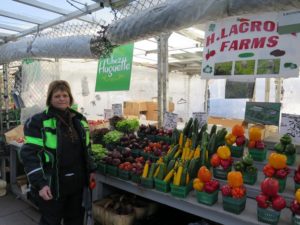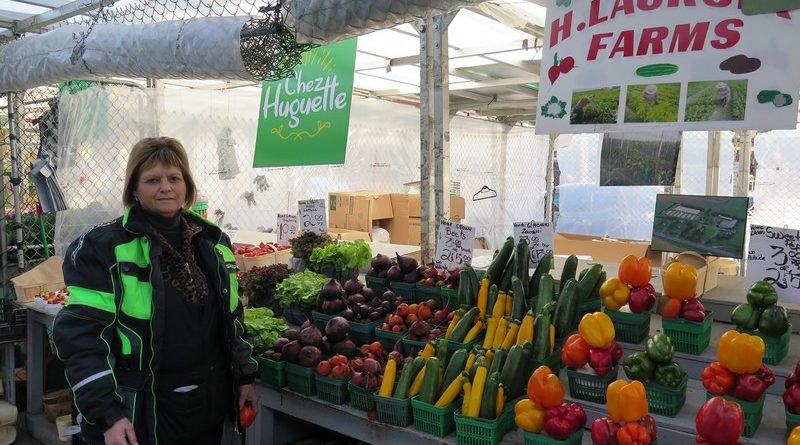The ByWard Market at 192 years

Photo John Chenier
John Chenier
The outdoor fresh fruit and vegetable vendors at the ByWard Market have come and gone for another year. Judging from the remarks of some vendors interviewed during their final week, the end would come as a welcome relief.
There is a sense of pride in how long some of the producers have had stalls at the Market. For most, the connections go back generations. However, the long hours spent standing in all sorts of weather conditions, the arduous work involved with growing the produce, the rising costs to buy what’s needed to enter into the business combined with uncertain rewards—all of these factors pose a threat to the future viability of the Market.
Huguette Lacroix has been selling produce from the family farm for 44 years. She started when she was seventeen. But her children have all chosen career paths far removed from growing and selling vegetables and flowers. She knows when she retires, it will be the end of the line. Several other vendors face the same situation. There are some who would stay longer if hiring reliable help was a viable option. But finding someone willing to put in 10- to 12- hour days — hot or cold, with rain, sleet or snow — is not easy. For the future of the Market, it is not a matter of a generation gap; it is a generation schism.
Of course not all vendors find themselves in the same predicament. The Rochon family operates the Jardin Rochon Garden stall at the corner of Murray and ByWard. The multi-generation family farm in Edwards, Ontario is doing very well. In addition to the ByWard, it produces enough flowers and vegetables to supply stalls at ten other markets in the region. At the instigation of the up-and-coming generation, the Rochon farm has developed a growing Community-Shared-Agriculture (CAS) component to its business model. CAS members can pick up their basket of produce weekly or bi-weekly at 11 locations in the region (the By Ward is not one of them) or have the baskets delivered right to their door.
While that success story provides hope for the ByWard, it also shows that the way things were in the past does not indicate the way of the future. Farmers are looking for, and finding, new ways and places to get their products to consumers. The results from relentless pressures for change are evident in the ByWard precinct. There used to be 11 butchers; now there is one, maybe one-and-a half if you include La Bottega Nicastro and one more if you include the two delis as half each. Number of indoor fruit vendors: one.
Change has come to the product mix of the outdoor vendors as well. Clearly, there are no more live chickens or about-to-be-skinned rabbits for sale. But there are more subtle changes as well. According to Madame Lacroix, even the mix of vegetables they grow and sell has changed over the years from the staples of green beans, carrots and potatoes to include more exotic fare such as peppers, herbs, eggplant, broccoli — and, ironically, heirloom carrots.
How did they fare this year? One vendor when asked that question pointed at what was an empty sidewalk. Years ago, she noted, the sidewalk was seldom as empty as it was that morning. Worse, the absence of shoppers was not an unusual occurrence. Several factors contribute to the decrease in the number of outdoor vendors over the years. Lack of shoppers is clearly one of them. For the Market, which is already going through tough times, this is not a good sign.
It used to be that the Market would attract large crowds during the day and be almost deserted after sunset. In the ‘60s and ‘70s, many Ottawans considered it foolhardy and dangerous to enter the Market after dark. Some today might still consider it foolhardy and dangerous, but it is clear that many more don’t feel the same way. On most days, the busy times begin after 5 pm. Even during the day when it is busy, many people have come to the Market for a coffee and a pastry or brunch rather than a load of vegetables.
Can it be saved?
Public Markets of Montreal, “a corporation of 250 members, vendors and merchants from the city’s 15 markets,” is often held up as the gold standard of farmers’ markets. Clearly the structure brings a lot of different interests together under one big tent.
By comparison, the history of the ByWard Market over the past 50 years is one of conflict and division over who should be allowed to sell what, where and when. Currently, there are three types of outdoor vendors in the ByWard – vendors that sell only what they produce on their own farms, vendors that sell mostly what they produce but supplement their sales with small amounts of imported fruits and vegetables, and lastly, the vendors that sell on behalf of other producers from near and far.
Those still selling produce in the final week in October represented all three types and it did not take much probing to discover that there is little love lost among those who differ along that spectrum.
In the past, it seems like little effort was directed at seeking compromise or considering what it was that brought people to the Market in the first place. In the absence of consensus or direction, the ByWard precinct has drifted and taken on a different role.
Part of the problem at the moment is that there are numerous ideas of what’s wrong — along with the quick fixes that would supposedly solve everything. Do shop owners and outdoor vendors recognize that curtailing the availability of products has hurt all of them by driving consumers away from the Market?
Which leads to the question: Has the City waited too long to repair the damage and change the direction?
The hope is that over the winter months the various “rethink the market exercises” currently underway will yield a plan for the Market to regain its “market appeal” and attract more people. But the management team also needs to come up with a way to better accommodate and attract more and varied vendors who aren’t prepared to operate a stall seven days a week for six months and who can sell their wares under more favourable conditions at numerous venues around the region.
Meanwhile, most of the produce vendors are gone for the year. If you are wondering what happened to all the produce left in the stands at the end, each producer has their own favourite charity, be it the Food Bank, The Shepherds, The Mission and so on who take it all away, leaving empty stalls, hopefully only until next May.
Republished with permission of the Lowertown Echo de la Basse-ville.
